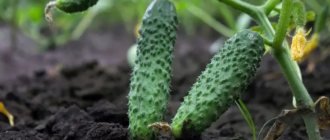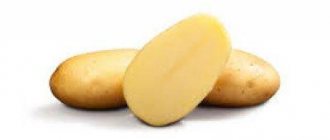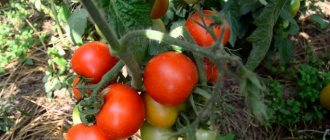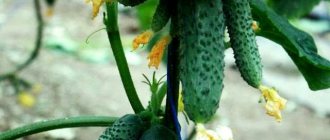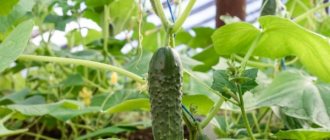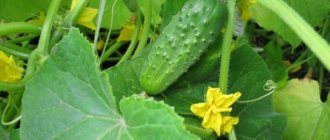Magdalena F1 cucumber is one of the Dutch hybrids known throughout the world due to its excellent commercial qualities and ease of care. Its plants produce an excellent harvest, do not require pollination by insects, and the fruits are neat, even, juicy and aromatic.
| Landing location | Ripening time | Mode of application | Fruit length | Group | Fruit smoothness | Pollination method |
| Universal | Early ripening (35-45 days) | Universal | Short (gherkins) - less than 10 cm | Hybrid | Slightly lumpy | Parthenocarpic |
History of variety development
This early-ripening hybrid variety was bred by Dutch breeders from Monsanto Holland BV at the beginning of this century. Foreign vegetable growers, including Russian ones, immediately drew attention to this variety. Over time, it passed variety tests in Russia and was included in the State Register of the country in 2009. According to the description of experts, this variety can be grown in most Russian regions in garden beds and film greenhouses on private farms.
Description
Cucumber Magdalena F1
This hybrid is of early ripening, so greens can be harvested for pickles already 35 days after seed germination, and for gherkins – a week and a half later.
The Magdalena F1 cucumber belongs to the parthenocarpic type; this indeterminate hybrid has no growth restrictions, so vegetable growers usually pinch the top of the central vine at a height of 2.0-2.3 m to activate the growth of lateral shoots. It is on them that this cucumber will continue to bear fruit after it ends on the central shoot. The number of side shoots is moderate.
Related article:
Bunch cucumbers: growing method
The shoots are well leafy, the foliage itself is large, rounded, heart-shaped, with slightly wavy edges, rich emerald color.
Ofazende.ru also recommends cucumber Maria F1
The flowers are medium in size, yellow in color, appear in bunches of nodes, each of which can have up to 3 ovaries.
Ripe fruits are gherkin type, cylindrical in shape. The skin is smooth, with medium-sized tubercles and soft small light spines and medium-density pubescence. The color of the skin is dark emerald.
Cucumber Magdalena F1
The length of cucumbers at the pickle stage is 4-5 cm, at the gherkin stage – 5-7 cm. The diameter of pickles is about 1.2 cm, and gherkins – 1.5-2.0 cm. The weight of cucumbers at the pickle stage is about 10 g , at the gherkin stage – 15-17 g.
The pulp of the collected greens is compacted, juicy, light green in color, with small seeds at the stage of milky maturity. Bitterness in fruits is absent at the genetic level.
Collected pickles and gherkins tolerate transportation well and can be stored for quite a long time in appropriate conditions.
Features and Benefits
The products of several companies producing seeds from Holland are represented on the Russian market. Among the famous:
- Bejo Zaden;
- Seminis;
- Rijk Zwaan;
- Enza Zaden and others.
Dutch varieties of cucumbers are also sold by Russian agricultural companies, indicating the originator on the bags. Mostly hybrid forms are presented, labeled F1.
On a note! F1 hybrids have nothing to do with genetically modified products. Hybrids are based on complex crossing (sometimes from several parental forms), resulting in plants with high yields and disease resistance.
Dutch selection cucumbers are valued for a number of advantages:
- precocity;
- long fruiting;
- high marketability of fruits (evenness, homogeneity);
- excellent germination of seed material;
- rapid adaptation of plants to different climatic conditions;
- a diverse range of varieties and hybrids (according to ripening time, size, purpose).
Among the “Dutch” varieties there are early and ultra-early varieties, early ripening varieties, and late hybrids. Cucumbers that require insect pollination and parthenocarpic forms have been bred.
At the genetic level, resistance to pest attacks and infections (especially fungal diseases) is inherent. This is especially important for plants grown in greenhouses and greenhouses, where pathogenic background accumulates over the years. Thanks to this resistance, there is no need to use toxic fungicides and insecticides on plantings, while still obtaining an environmentally friendly harvest. Seed material from Dutch agricultural companies is often sold processed, so before sowing there is no need to prepare the seeds for sowing (treating, soaking). These seeds differ in color: pink, green, blue.
Disadvantages include the high cost of seeds (especially new hybrids), as well as the inability to collect seed material from most cucumbers. In hybrid forms, the specified characteristics are not preserved in subsequent generations, so every year you need to purchase the seeds of your favorite cucumbers.
Main characteristics of the variety
This cucumber hybrid has high resistance to the main diseases of cucumber crops, moreover, it can equally well tolerate temporary drops in temperature and extreme heat, without reducing growth, without shedding flowers and ovaries, and the fruits themselves continue to ripen. Also, the Magdalena F1 cucumber is not picky about the quality of the soil.
Productivity
Cucumber Magdalena F1
The yield of cucumber Magdalena F1 is quite high for the gherkin type - up to 8 kg from each square of area.
Related article:
How to grow a good harvest of cucumbers
Area of application of fruits
Thanks to their pleasant taste, these cucumbers are good in salads and appetizers, as well as in canned food - salted and pickled gherkins never become bitter, remain dense and aromatic, and no voids form in them even during heat treatment.
Diseases and pests
It should be noted that the hybrid cucumber Magdalena F1 is highly resistant to most diseases, including brown spot, cucumber mosaic virus, and powdery mildew.
Popular varieties
The list contains hybrid forms of first generation cucumbers (labeled F1), which are grown by amateur gardeners and farmers. Among them:
- Marinda is one of the most popular Dutch hybrids among gardeners. It has been known in Russia since the 90s of the last century and is included in the State Register. Zelentsy are tasty, uniform in size, suitable for marinades and canning. The advantages include the plasticity of the hybrid form, resistance to major diseases, and excellent yield indicators (up to 30 kg/m² in greenhouses). Purpose – universal;
- cucumber Karin F1 is a variety of the famous hybrid Claudius, superior to it in terms of yield and taste. Belongs to the bunch type, the number of ovaries is up to 7 pieces in one sinus. Greens with numerous pimples and white spines. The taste is excellent. From 1 m² up to 13-15 kg of fruits are collected (in a greenhouse);
- Ecole - cucumber has been included in the catalog of the State Register of the Russian Federation since 2007. The hybrid is valued for its excellent taste and the ability to collect gherkins. From 1 m2 they collect up to 20 kg (greenhouses), on beds - up to 3-5 kg;
- Pasadena is a parthenocarpic species, with good yield (up to 12 kg/m²), high resistance to a number of infections. The fruits are regular cylindrical in shape, dense, with thin tuberous skin. The taste is pleasant, the flesh is crispy and juicy. Areas of use: salting, preservation, marinades;
- Masha is an early parthenocarpic cucumber. The originator is Monsanto. First generation hybrid, salad, canned type. The first greens are harvested 40-42 days after germination, up to 11-12 kg of fruits are harvested from one square meter;
- Claudia is a cucumber from Seminis. A very popular hybrid, on the basis of which domestic companies have created several similar species: Claudia Agro F1, Kucha-Mala, Partner. According to the type of ripening - mid-early, it grows well in any region (open ground, shelters). Grown in Belarus and Ukraine. Resistant to a number of diseases, greens have no bitterness. The fruits are up to 12 cm in length, gherkin-type, emerald in color with slight spotting. The peel is thin, the thorns are white and soft. The taste of greens is good. Used for canning, salads;
- Herman - greens of excellent presentation, dense, beautiful. The hybrid belongs to the group of ultra-early species, producing the first fruits already on the 35-38th day.
The main advantages of the variety
Of the main advantages of this hybrid cucumber, the main ones should be noted:
- the hybrid is resistant to many cucumber diseases;
- pleasant sweetish taste and typical cucumber aroma of greens;
- stable fruiting even in unfavorable weather conditions;
- wonderful appearance of the collected gherkins;
- fruits are approximately the same size and weight;
- early fruit ripening;
- The seed material has a high germination rate - above 96%.
Features of planting and care
Usually, the seeds of this hybrid are planted in open ground only in the southern regions of the country, when the soil warms up to 14-15 degrees Celsius. Typically, in the south of the country, seeds are planted in the ground in early May, and in colder regions - in the last ten days of May - the first ten days of June.
In other areas, this cucumber is grown by seedlings. To do this, seed material is planted in separate pots approximately 30 days before the intended transplantation to a permanent place - approximately in the last ten days of April.
Related article:
Cucumber Siberian Garland F1 – description and characteristics of a super-yielding hybrid, reviews
You should not plant cucumber seeds in large containers and then pick them - cucumbers have very delicate roots that are easily damaged by frequent transplants, as a result, the transplanted plants suffer for a long time in the new place and grow poorly. And after planting in a permanent place, fruiting in such plants will begin a couple of weeks later than even those cucumbers that are planted with seeds in the ground.
Cucumber seedlings are usually planted in open ground at one month of age, when the plants have at least 4 permanent leaves.
The distance between adjacent planting holes is 0.3 m, and the width between rows is 0.7 m.
Landing rules
Magdalena f1 is not capricious regarding soil characteristics, unlike such a hybrid as Swallow f1. The variety can be planted in both loamy and sandy loam soil. The main thing is that the land for the cucumber should have neutral acidity, and the site should be on a plain or hill so that the water drains easily and does not create swamps at the roots of the plants. The best predecessors of cucumbers are tomatoes or legumes.
Preparing the bed
The beds for the variety begin to be prepared in the second half of September. In the fall, the soil under the cucumber is dug up to the length of a shovel, disinfected with a solution of copper sulfate or potassium permanganate and fertilized with mullein or compost mixed with hay.
With the onset of spring, 3 days before planting, the area for the Magdalena f1 hybrid is loosened by 15-20 cm, weeded and fed with wood ash.
Germination of seeds
Magdalena seeds are planted for seedlings in late April. The variety material is added to small peat pots (15-20 cm high), to a depth of 1.5 cm. Sand, rotted sawdust, and humus must be added to the soil. The cucumber is germinated at a temperature of 23-24, watered every day in the evenings. When the second leaf appears, Magdalena f1 is fertilized with chicken droppings or coal powder. Before planting in the ground, the variety must be hardened for 7-9 days.
Planting seedlings
The cucumber in question begins to be transplanted into a greenhouse or beds on the 20th of May. You can transfer seedlings only when the ground warms up to 14°. The sprouts of the variety should already have 3 leaves blooming. Up to 3 Magdalena plants can be safely placed per 1 m². The optimal distance between bushes is 35-40 cm. The recommended row spacing for cucumbers is 60-65 cm.
Further care
In the future, cucumbers of this variety should be cared for as follows:
- water regularly;
- apply fertilizing;
- loosen the soil and remove weeds;
- tie cucumber vines to trellises or special cucumber nets;
- Collect fruits regularly - at least 2 times a week.
Watering this cucumber hybrid is carried out in the evening with settled warm water. In this case, you need to make sure that drops of water do not fall on the leaf plates and shoots. The amount of water per watering should be moderate so that the soil is moistened by only 30-40 cm.
Important! There should be no stagnation of moisture in the garden beds where cucumbers grow, otherwise the plants may develop root rot.
After each watering, the soil should be loosened to remove the dry crust that forms on the surface of the root zone. You should also regularly remove weeds along with the roots from the root zone at least once a week.
To prevent the yield of this hybrid from decreasing, fertilizing should be applied to the soil during the season. Usually alternate application of organic matter and complex mineral fertilizers.
Cucumber vines should be tied to trellises as they grow; in this case, it is easier to care for the plants and also to collect ripening greens.
Ofazende.ru told how to properly tie cucumbers in the garden
Ripe gherkins should be harvested regularly - every two to three days, so that new ovaries immediately begin to form.
Related article:
What harms cucumbers
